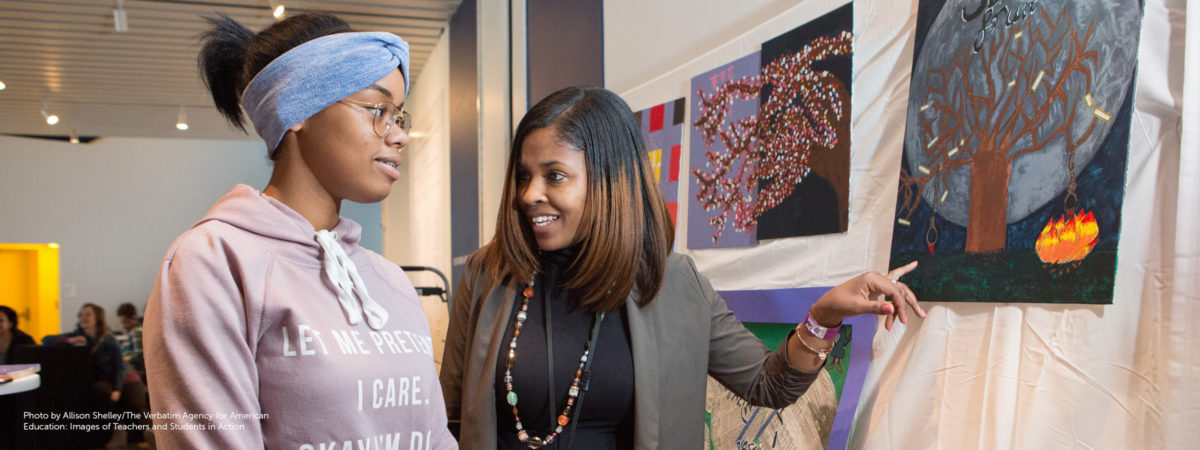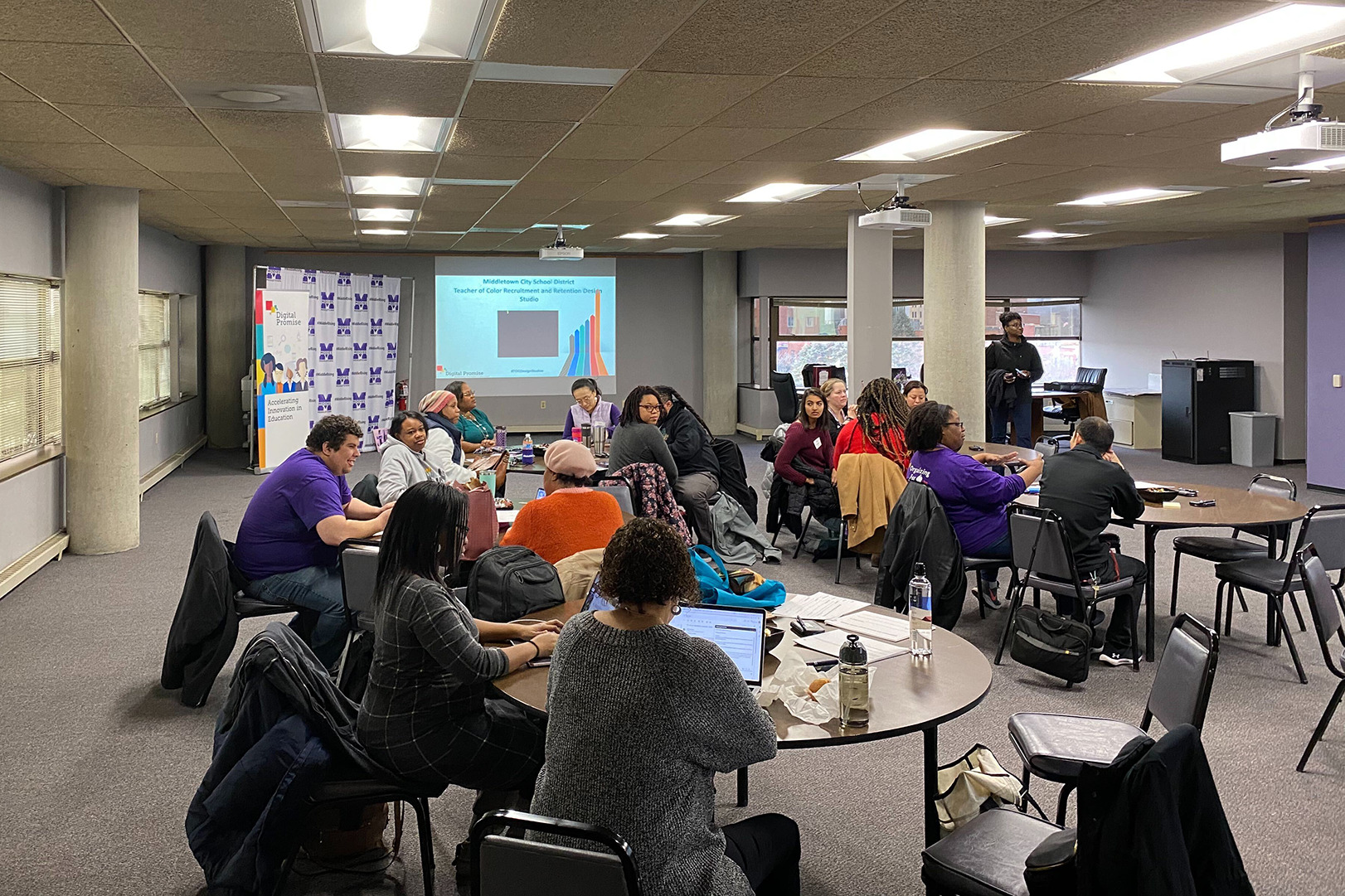
September 14, 2020 | By Malliron Hodge
Black, Indigenous, students of color make up more than 50 percent of the K-12 student population, yet the number of non-white teachers in schools is only 20 percent. How can we collaborate with and learn from teachers of color to create solutions to address this systematic shortage?
In Adrienne Maree Brown’s recent book, Pleasure Activism: The Politics of Feeling Good, she states, “Our radical imagination is a tool for decolonization, for reclaiming our right to shape our lived reality.” Our team at Digital Promise wondered: What might a new reality look like where teachers of color lead the process to co-design solutions based on their lived experiences?
With support from the Walton Family Foundation, we aimed to take a different approach by centering teachers of color in creating solutions for recruitment and retention. Over the last 10 months our team has collaborated with an advisory council of 12 teachers of color representing districts from the League of Innovative Schools, public charter schools including an early childhood center, and private schools across the country. The teacher advisory council has co-led “design studios” with teachers of color in their respective regions.
Digital Promise created Teacher of Color (TOC) Design Studios to serve as a welcoming, inclusive, and trusted space for Black, Indigenous, People of Color (BIPOC) teachers to share their experiences and brainstorm teacher-centered solutions to improve the pipeline, recruitment, and retention of aspiring and current BIPOC teachers. Our design studios invite teachers within their respective regions to develop solutions that involve four groups of stakeholders: students, teachers, administrators, and policymakers. In breakout groups, teachers generate multiple ideas, collectively select two to three solutions to expand further, and discuss feasibility and potential barriers. Finally, the groups present their leading solutions to decision-makers from across their region or state.

We launched the Design Studios in February in Middletown City School District (Ohio) with 25 teachers from the district.
We launched the Design Studios in February in Middletown City School District (Ohio) with 25 teachers from the district. Ayesha Winfrey, a paraprofessional-turned-student teacher who followed in her grandparents’ footsteps to become an educator in the district, was our TOC advisory council member co-host. In the district, students of color makeup 44.4 percent of the student population, and educators of color make up 6.5 percent of the staff. We learned the participating teachers were interested in establishing an ongoing affinity community and wanted to create a way to share advancement opportunities within the district more easily. One teacher shared that she was “thankful for the space to connect with other teachers that looked like me.”
Our plan was to host design studios in the remaining six regions, but COVID-19 required us to rethink how the in-person sessions could be hosted virtually. While hosting sessions in-person is a valuable experience, we recognized that we could create a design studio model that would be comparable if we deepened the focus on teachers even further. In addition, the decision to go virtual was led by our TOC advisory council, making the choice all the more powerful.
Our first virtual design studio was hosted by Avonworth School District and Hampton Township School District in Pittsburgh, Pennsylvania. Our goal remained the same: to provide an opportunity for educators of color to rethink ways to increase the recruitment and retention of teachers of color. However, to accommodate the virtual environment, we had to shift our approach. Co-led by advisory council members Deshanna Wisnieswki and Michael J. Warren, we planned two, 90-minute sessions, one week apart, to accommodate the time commitment of the attending teachers and allow our team to make necessary iterations between the sessions.
Our space was centered on honoring and acknowledging the identities and lived experiences that teachers of color bring to their profession. The focus on identity surfaced not only in how our team co-created the space, but also in how we acknowledged the ways each person arrived at the session. Between the studios, the murders of Breonna Taylor and George Floyd had hurtled to the forefront of news broadcasts and to the top of our minds. Given that our space brought together teachers of color, with about 80 percent of our attendees identifying as Black, we provided a space to share reactions and honest truths. This moment allowed teachers to show up as full humans—raw, vulnerable, and true. It also allowed us to highlight not only the importance of their being together, but also how this work connects to the significance of sharing these moments with students who look like them in their own classrooms.
Later this fall, we’ll continue to facilitate virtual design studios co-led by members of our advisory council in Orlando, Huntley (Illinois), Baton Rouge, Lexington (South Carolina), and Cincinnati. As we plan for our remaining design studios, we are keeping these considerations in mind:
At the conclusion of this project, we will convene superintendents, district leaders, higher education leaders, community members, policymakers, and education leaders for the National Teachers of Color Showcase: Reimagining Recruitment and Retention. At the showcase, participants will present the concepts that were developed by teachers of color at our design studios, with the hope that they will lead to promising solutions to address the teacher of color shortage in the United States.
Stay tuned for additional updates as we forge ahead to the national showcase. To learn more about our efforts to improve the recruitment and retention of teachers of color, refer to this blog post by Kimberly Smith and read our literature review, which summarizes research on factors that contribute to the continuing decline in the teacher of color workforce.
By Sharin Jacob and Quinn Burke
By Dr. Kyle Dunbar and Katie Wilczak
By Elliott Barnes and Sara Mungall